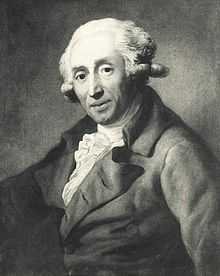Ernst Platner

Ernst Platner (June 11, 1744 – December 27, 1818) was a German anthropologist, physician and philosopher born in Leipzig. He was father to painter Ernst Zacharias Platner (1773-1855).
He received his education at the University of Leipzig, where in 1770 he became an associate professor of medicine. Later at Leipzig, he was appointed a full professor of physiology (1780) and philosophy (1811).
Platner was a follower of the teachings of Leibniz, and was author of Anthropologie für Aerzte und Weltweise, one of the more important anthropological works of the Spätaufklärung (epoch of German literature). In the field of anthropology, he was a proponent of a concept that demonstrated the interplay of body and soul through physical persuasion. His work in this field was influential to scholars that included Johann Gottfried Herder, Friedrich Schiller and Karl Philipp Moritz.
Platner is credited with originally coining the term Unbewußtseyn (unconscious).[1][2]
Selected publications
- Anthropologie für Aerzte und Weltweise (Anthropology for physicians and the worldwise), 1772
- Neue Anthropologie für Aerzte und Weltweise (New anthropology for physicians and the worldwise), 1790
- Über den Atheismus. Ein Gespräch (About atheism, an interview), 1783
- Philosophische Aphorismen (Philosophical aphorisms); Vol. 1: 1776, Vol. 2: 1782
- Quaestiones physiologicae (Questions of physiology), 1794
- Quaestiones medicinae forensis (Questions of forensic medicine), 1797–1817
Notes
- ↑ Ernst Platner, Philosophische Aphorismen nebst einigen Anleitungen zur philosophischen Geschichte, Vol. 1 (Leipzig: Schwickertscher Verlag, 1793 [1776]), p. 86.
- ↑ Angus Nicholls and Martin Liebscher, Thinking the Unconscious: Nineteenth-Century German Thought (2010), Cambridge University Press, 2010, 9.
References
- This article is based on a translation of an article from the German Wikipedia.